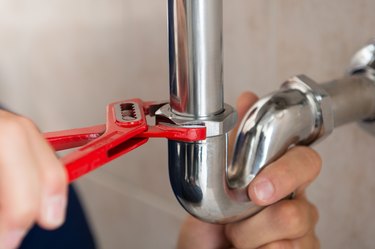
Venting is critical to the operation of a residential or commercial plumbing system. The typical vent system consists of a network of pipes that connect to every drain P-trap and extend via a main stack that pokes through the roof just above the main bathroom. For one reason or another, it may be impractical or impossible to construct this main vent through the roof, so it's usually permissible to extend it from another part of the house. Air admittance valves (AAVs), also known as Studor valves, are alternatives to roof vents for single fixtures, but they aren't legal for toilets or allowed in every locality, and they have a habit of failing.
The Drain Waste Vent System
Video of the Day
Everyone knows what drain and waste pipes are, but not everyone understands the function of the vents. Drain pipes are those connected to fixture P-traps. These empty into larger waste pipes that connect to the sewers. Water running through these pipes tends to create a suction behind it, and that suction can be strong enough to suck water out of the traps and release sewer gases into the house. That's where vents come in.
Video of the Day
The vent pipes generally connect to the traps at a point just above the horizontal section that directs water into the drain. They allow air into the plumbing system to prevent the buildup of negative pressure. When a vent becomes blocked or has bad installation, water drains slowly or gets stuck, giving the impression of a blockage when no blockage is there.
Alternative to a Roof Stack
The main stack is the heart of the venting system. All the vents connect to it through branch lines, and it vents the main toilet, the most important plumbing fixture in most houses. If you can't put the main stack through the roof, most local plumbing codes allow you to put it through a wall instead, but there are conditions. It must extend vertically past the top frame of the highest window in the house, and in some locations, it may even have to extend above the roof line. It's best to check with your local building department to find out the regulations that apply in your area.
This configuration has disadvantages, the main one being that an elbow in the stack makes it harder to clean in the event something gets stuck inside. Besides that, a stack that extends outdoors is vulnerable to freezing, and ice blockages could affect the operation of your plumbing system.
Pros and Cons of Studor Vents
If you're installing a new sink in a lower floor, you may want to avoid running vent pipes through walls to connect the sink to the main vent. That's why you need Studor vents (AAVs). A Studor vent is a small mechanical device that opens when it detects negative pressure in the drain pipe to allow air into the system. Many localities allow Studor vents inside the sink cabinet, so you can connect one on or just above the horizontal arm of the P-trap. That's definitely convenient, but there's a problem. Because it has a spring-loaded valve, a Studor vent can malfunction or simply wear out. Of course, you can always replace it, but if you're not a plumbing-savvy type, you might mistake a malfunctioning AAV for a drain blockage and waste days or months trying to clear your drains when the vent is the problem.
The Chicago Loop
Sinks installed in kitchen islands present a problem when it comes to venting. Because the vent must extend horizontally from the drain and can't slope down with respect to the vent outlet, there's literally no way to install a conventional vent in an island. The Chicago loop is the answer. It connects just above the trap and extends vertically a foot or so before making a loop and extending down the drain. As long as the top of the loop is above the point where water could reach if the drain becomes blocked, the vent pipe is always clear, and air can always get into the drain.